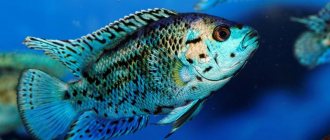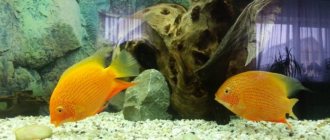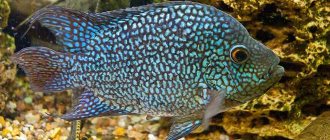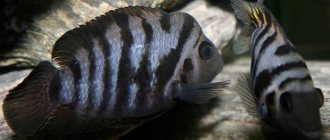Meek's cichlid (Thorichthys meeki, formerly Cichlasoma meeki) is one of the most popular cichlids due to its bright red color, easy-going nature and low demands.
Meeka is quite small for a Central American cichlid, the fish is approximately 17 cm in length, and is very slender.
This is a good fish for both beginners and pros. It is unpretentious and gets along well in large aquariums with other fish, but it is better to keep it with large fish or separately.
The fact is that one day they can become very aggressive when the time comes to spawn. At this time, they drive away all other fish, but especially smaller relatives.
During spawning, the male cichlazoma meeki becomes especially beautiful. The bright red color of the throat and gill covers, together with the darkened body, should attract the female and repel other males.
Habitat in nature
Thorichthys meeki was described in 1918 by Brind. It lives in Central America: Mexico, Guatemala, El Salvador, Honduras, Nicaragua, Costa Rica and Panama.
It is also adapted in the reservoirs of Singapore and Colombia. Now some individuals are still imported from nature, but the majority are bred in amateur aquariums.
Meek cichlazomas inhabit the lower and middle layers of water in slow-flowing rivers, ponds, and canals with sandy or silty soil. They stay close to overgrown areas, where, on the border with open windows, they feed on plant and animal food.
Description
The body of the meek is slender, laterally compressed, with a sloping forehead and a pointed muzzle. The fins are large and pointed.
The size of Cichlazoma meek in nature is up to 17 cm, which is quite modest for cichlids, but in an aquarium it is even smaller, males are about 12 cm, and females are 10.
The lifespan of the cichlas meek is about 10-12 years.
The most prominent part of the coloration is the gills and throat, they are red in color, part of which also extends to the belly.
The body itself is steel-gray with purple tints and dark vertical spots. Depending on the habitat, color may vary slightly.
Appearance Features
Appearance of meek fish:
- Fish size . In an artificial reservoir, the length of an adult is about 12 cm. In its natural habitat, the meeka can grow up to 15 and even 20 cm.
- Body . Elongated and tall, slightly flattened on the sides. The ridge is quite strongly curved, which is one of the most characteristic features of the appearance of representatives of this species of cichlases.
- The tail is very beautiful, reminiscent of a luxurious fan.
- The head is elongated, with a small mouth opening and a sloping forehead.
- Fins . The anal and dorsal ones are long and originate from the middle of the body, ending in the tail area. The paired fins have spectacular bright blue dots, while the unpaired fins are decorated with scarlet edging along the edges.
- Color. The body of the fish is covered with silvery, shining scales, casting a lilac, green or yellow color in the light. The neck is painted in scarlet tones. Spots and stripes of dark tones are randomly located along the entire body, effectively contrasting with the main color. Specimens with golden spots located next to the gills are also found in nature. Such individuals are very rare, and therefore are especially valued by aquarists. According to scientists, the color of the meek largely depends on its habitat and the conditions of its maintenance.
Sexual differences . Distinguishing a male from a female is not difficult even for a beginner in aquarium keeping. Males are larger in size, have a bright and rich color, as well as slightly pointed dorsal and anal fins. The fins of females are more smooth and rounded in shape.
Features of appearance. A characteristic feature of the meek fish is its ability to spread its gills when facing potential danger. This is a truly terrifying sight, since the gills begin to appear huge, and the dark spots located on them look from the outside like a scary mask. For this reason, many aquarists nicknamed this fish “mask fish”.
How long do they live?
The average lifespan of a meek is about 10-12 years.
And with good living conditions and a balanced diet, your pet’s eyelids can be extended up to 15 years.
Difficulty in content
Cichlazomas meek are considered simple fish, well suited for beginners, as they are quite adaptable and unpretentious.
In nature, they live in bodies of water that differ in water composition, temperature, and conditions, so they had to learn to adapt well and survive. But this does not mean that caring for them is completely unnecessary.
You can also note that they are omnivorous and not picky about feeding. This is also one of the most peaceful cichlids that can live in a community aquarium, although until it begins to prepare for spawning.
Content Features
In an aquarium for keeping "Cichlazoma Meeka", there should be many places where the fish could hide, for example, grottoes made of stones. Plants must be strong and have a good root system, since these fish are burrowers. Fish are distinguished by their peaceful and accommodating nature, especially if they grew up together. Males become aggressive during spawning, when they prepare places for spawning. During this period, the male can enter into a fight with any fish that approaches him. The water for keeping these fish should have a temperature of 20 to 26 C, and its hardness should be in the range of 10 - 20. You can feed the “Cichlid Meek” with any food for aquarium fish.
Video. Cichlazoma Meeka in the aquarium:
In order to keep a small flock of fairly large adult cape, a hundred-liter aquarium is enough. Fifty liters may be enough for young fish. A meek family consists of one male and two or three females, which he will guard and protect. Some literature indicates that meeks live in pairs and are essentially monogamous, but in my case they live in just such a flock and no deviations in their behavior are observed.
Video. Meeka's fight with Parrot:
The main thing in their maintenance is to prevent overcrowding of their living space, since as a result of this process the aggressiveness of the fish increases and strife begins.
Video. Meeka chases other fish:
It is also worth adding other fish to them according to their size: fish that are too large will cause anxiety in the fish. So, I had a case where one male black-striped cichlasoma kept an entire group of five young females in terror. But as soon as I left him for a week, the meeks quickly got stronger and got used to it, and when I returned the male to his place, they easily reined him in. Like almost all other cichlids, each of the meeks has its own individual behavior and habits, each of the fish is individual.
Video. Meeeeka's fight with a black-striped cichlid:
An aquarium with meeks does not require any special equipment; in fact, everything is standard. You need an internal or external filter, you need a heater, and it is desirable that it has a thermostat. The temperature required for these fish is in the range from 24 to 28 degrees Celsius, although these fish can easily withstand temperatures as low as 18 degrees, but this is not advisable. Fish need a weekly water change of 30-35% of the total water volume, since they are difficult to tolerate pollution. Meeks need shelters just like any other cichlids. Suitable snags, ceramic pots, stone grottoes and caves. If we talk about plants, then each of the fish treats them in its own way, based on its character. Some of the fish don't care about plants, but the other part of them tends to rearrange everything to their taste and can damage or tear out plants.
Some women from time to time have a desire to refurbish their homes, and neither soil, nor stones, nor plants become an obstacle to them. And therefore, in order to avoid such excesses, plants with a developed root system should be planted - such as hard-leaved anubias or large echinodorus. Plants are best planted in pots. After all, if the aquarium is used as a decorative pond, then these vessels can be covered with driftwood or stones, or even buried in the ground. Other cichlids can successfully coexist with meeks, but fights between them are not excluded.
not to keep meeks with closely related species, as unwanted crossbreeding may occur. It cannot be kept with cichlazomas and other similar species, which include the black-striped “cichlazoma” (archocentrus), golden cichlazoma and some others.
To avoid fights, these fish should be kept together from a young age, so that they are already accustomed to each other and know well the characters of each individual in the school. They simply eat other small fish. And therefore, if you want to choose neighbors for the meeks, then it is better to stop at the loricariid catfish, which fiddle around at the bottom and don’t touch anyone - the meeks won’t touch them either. It is unwise to keep shellfish with them - the meeks will drag them around, gnaw them, and eat the antennae.
Keeping in an aquarium
For a couple of meek cichlids you need at least 150 liters, and for a larger number of fish from 200. Like all cichlids, meeks need clean water with a moderate current. It is best to use an external filter for this. It is also important to regularly change the water with fresh water, approximately 20% of the volume, once a week.
Meeks love to dig in the ground, so the best soil for them is sand, especially since it is in it that they like to build a nest. Also, for meeks, you need to place as many different shelters as possible in the aquarium: pots, snags, caves, stones and other things. They love to hide and protect their possessions.
As for plants, it is better to plant them in pots to avoid damage and digging. Moreover, these should be large and tough species - Echinodorus or Anubias.
They adapt to water parameters quite well, but it is better to keep them at: pH 6.5-8.0, 8 - 15 dGH, temperature 24-26.
In general, we can say that this is a fairly unpretentious cichlid, and with normal maintenance it can live in your aquarium for many years.
Content
Caring for Meeka cichlids is not difficult, because these fish are clean and have strong immunity. Meeks require a weekly change of part of the water and cleaning of the aquarium. When decorating an aquarium, pay attention to stones and driftwood, which cichlids especially love.
Aquarium
Cichlids are not exactly small fish, so the size of the aquarium is selected based on the size and number of inhabitants.
| 1 fish | 20–30 l |
| Pair of fish | 50 l |
| Small flock | 150–200 l |
The aquarium is equipped with a lid, because Meeks easily jump out of the water and die.
Water parameters
Plants
Cichlazomas are famous for their love of digging up roots, so only plants with strong roots and hard leaves are planted in their aquarium, or artificial plants are used. To prevent damage to the roots, plants are also planted in pots.
Suitable:
- Anubias;
- Vallisneria;
- Echinodorus;
- Cryptocoryne.
Priming
These fish like to dig through the soil, so the soil should not be too dirty or contain sharp particles. Small rolled pebbles or coarse sand work well.
View this post on Instagram
Publication from Roman Novikov ??????? (@romanovikov80) Jul 20, 2018 at 9:58 am PDT
Compatibility
It can easily live in a community aquarium with other large fish. They become aggressive only during spawning. During this time, they will chase, and may even kill, fish that bother them in their territory.
So it’s better to keep an eye on their behavior, and if this happens, put away either the meek or the neighbors. They are compatible with angelfish and acaras, but not with astronotus, which is much larger and more aggressive.
They like to burrow and move soil, especially during spawning, so keep an eye on the plants, they may be undermined or damaged.
Cichlazomas meek are excellent parents, monogamous and form a pair for many years. You can keep more than one pair of fish in an aquarium, but only if it is large enough and has hiding spots and nooks.
Breeding
Meek's cichlids can reproduce in a community aquarium without any problems.
With proper care, they can be bred even in a small aquarium. In order to obtain offspring of Meek's cichlazoma, it is necessary to purchase an already formed pair in advance. Or purchase a small flock of young animals; over time, they will form pairs on their own.
As soon as it becomes clear that your pets are about to spawn, it is recommended to move their neighbors away to prevent attacks from future parents. It is not advisable to transplant the cichlids themselves, since such actions can provoke stress and, as a result, the cancellation of mating games.
To further stimulate spawning, it is necessary to increase the water temperature by several degrees, but on the contrary, reduce the hardness. The softer the water, the greater the chances of getting offspring, since eggs develop much worse in hard water.
The initial stage of spawning is the preparation by the male of a place for eggs. Most often they look for a wide, flat stone (it is recommended to arrange it in advance), which is thoroughly cleaned. As soon as the place is ready, the female lays eggs on it, which are immediately fertilized by the male.
After this, throughout the entire period of ripening of the eggs, the parents will diligently look after them, eating unfertilized eggs and giving maximum access to oxygen to the ripening ones.
From the moment the eggs are laid until the fry can swim independently, it takes from 5 to 7 days. As soon as the first attempts of the juveniles to swim are noted, they need to be fed. For this, plankton and artemia nauplii are used, and as they grow, cyclops and crushed tubifex are added. It is also allowed to use special food for fry of industrial origin.
Puberty occurs at 8, less often at 12 months.
Fish become sexually mature at 8-12 months. When kept in a herd, the pair separates from the rest of the group and begins to keep to themselves. When kept in an aquarium, such pairs demonstrate significantly greater affection for each other than in natural conditions, where they meet only during spawning and raising offspring.
a pair of Meeka cichlases next to the laid eggs
If in natural reservoirs Meek's cichlazomas lay eggs on an open substrate, then in an aquarium they prefer to spawn in shelters (if available). Moreover, some particularly energetic females manage to lay eggs in such a narrow place that a much larger male is physically unable to squeeze through to fertilize the eggs. This situation must be taken into account if you need effective spawning.
The laid eggs are guarded by both parents. There are usually from 100 to 400 eggs in a clutch. The incubation period lasts from 3 to 6 days, but the larvae begin to swim only after 4-5 days.
If the pair spawned in a common aquarium, you should move the eggs to a separate container or, if the fry have already swam, use a hose to transfer them to a nursery aquarium. Placing a pair ready for spawning in a separate aquarium is not a good solution. Once in new conditions, the fish experience severe stress and spawning, as a rule, does not occur.
The fry of Meek's cichlasoma are relatively small, at least smaller than those of black-striped cichlasomas. Starter food can be Artemia nauplii, Cyclops or artificial food. Attempts by some aquarists to feed the fry with crushed flakes in the first days led to the death of the brood. In general, fry mortality is highly dependent on the quality of food and water parameters and can be quite high.
Like all other cichlids, Meek's cichlids protect their brood, and the male and female participate together in this process, alternately fanning the eggs with their fins and caring for the hatched larvae. Being on guard all the time, breeders are ready to attack any fish that approaches their offspring.
We invite you to familiarize yourself with: Equipment and premises for keeping sheep
Despite the active protection of their brood, Meek's cichlids are less dangerous to their neighbors in the aquarium than other cichlids during the spawning period and often raise their fry without causing any harm to the rest of the inhabitants of the aquarium. In general, with some experience, keeping and breeding of Meek's cichlids is not is of great difficulty, which guarantees this beautiful fish its rightful place among the most popular American cichlids.
All aquarists unanimously say that breeding these black-striped cichlases is not difficult. And this is absolutely true! We can say that their reproduction occurs independently. But, as in any other business, to achieve good results you still need experience, and most importantly, effort.
Black-striped cichlasoma is a monogamous fish; the spawners form stable pairs on their own while still young. To form pairs, it is initially better to keep them in a small flock in equal proportions between males and females. Puberty occurs at the age of 7-10 months.
Cichlazoma meeka reaches sexual maturity at 8–10 months. It is not difficult to distinguish a female from a male: the male individual is brighter and smaller in size. In addition, the male's fins are longer and pointed, while the female's are rounded.
In order to stimulate the reproduction process, the spawning ground is set up following the following recommendations:
- it is desirable that the water temperature be higher than in a general aquarium, but within 24–26 degrees;
- the hardness of the medium is reduced by adding a little boiled water;
- constant aeration is required;
- Several flat stones are placed in the tank and plants are planted.
During this period, fish should be fed with high-quality live food. If the meek cichlazomas feel comfortable, mating games begin. The female lays her eggs on a flat stone that the male has previously chosen for her. Parents take care of the eggs, fanning them with their fins and cleaning the area around them.
Around the third day, larvae appear, which after another 3 days turn into fry. At this moment, the parents are placed in a common aquarium, and the young animals begin to be fed. The babies actively swim around the aquarium in search of food. They can be given Cyclops or Artemia nauplii, and artificial food for fry is also suitable.





